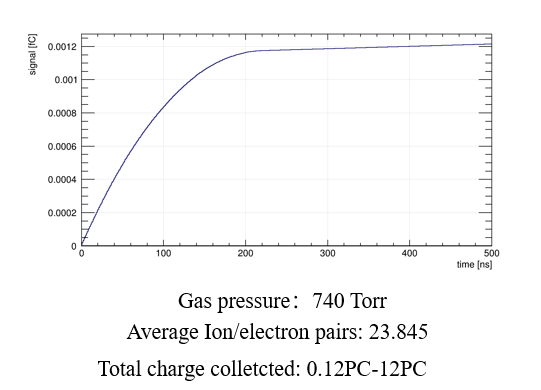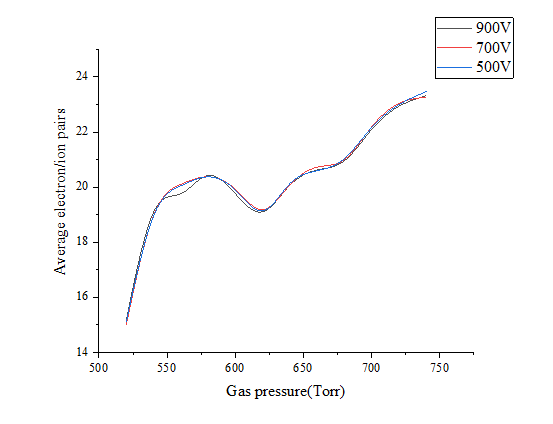the
with respect to one track I simulated before. Does the result mean the average of every 1000 tracks once a time or the integrated value of the 1000 tracks
the
with respect to one track I simulated before. Does the result mean the average of every 1000 tracks once a time or the integrated value of the 1000 tracks
OK,how to get the integrated value without calculating, neither the electrons/ions pair nor the number of electrons. my real experiment of the charge detected during 500 ns is in the range from 0 to 80PC.
So maybe what I simulated is wrong
Hi, hschindl
I think I know why the total charge is not 13 fC but 13 electrons - which is very small.

Although I simulate the number of 1000 tracks once a time now ,but the result seems a average value of charge collected. However in the actual experiment, the single shot of the laser proton’s number are about 10E7 to 10E9. So as the plot shows above, when the time is 500ns, the integrated charge is about 0.001202 fC, so I use this value to multiply 10E7 and 10E9, the result is about 0.12PC to 12PC
0.12PC to 12PC seems reasonable compared with the real condition. Do you think it is right?
There is one caveat: if you really have 107 - 109 protons crossing the detector at exactly the same time and ionising the gas, then you will have a very high charge density in the detector and the mutual interaction of the electron and ions in the gas will not be negligible any more. Unfortunately space charge effects are not easy to simulate in Garfield++.
Hi,
Thanks a lot for your reply and sorry for my late reply because something happened these days.
Actually I really don’t consider the space charge effect, and I just want to ask how I can simulate the induced current or integrated charge of 10E7 number of proton once a time but not through the calculating just simply through multiplying the number of protons(10E7) with the simulation results.
Hi,
Would you please help me to see the curve among the gas pressure and transient current peak and the integrated charge.
That’s my latest result
How many tracks did you simulate?
Hi,
Thanks a lot for your reply
I have simulated 1000 tracks
constexpr unsigned int nTracks = 1000;
You could increase the number of tracks to reduce the statistical fluctuations.
But, as I tried to explain in an earlier thread, if you have 107 tracks, I don’t see any point to simulate track-by-track fluctuations. So you might as well use TrackSrim and switch off straggling. Then you get the average energy loss (and number of electron-ion pairs) in your detector without any statistical fluctuations.
How to use TrackSrim and switch off straggling? So you think the mutational site is the reason of the statistical fluctuations? Do you think the relationship may follow a certain law such as Paschen law?
Didn’t you use TrackSrim in one of the first versions of your program? To switch off fluctuations you can do something like this:
TrackSrim tr;
const std::string file = "name_of_your_srim_output_file.txt";
if (!tr.ReadFile(file)) {
std::cerr << "Reading SRIM file failed.\n";
return 0;
}
// Set the kinetic energy of the particle [eV].
tr.SetKineticEnergy(100.e6);
tr.SetClustersMaximum(50);
// Switch off energy-loss fluctuations
tr.SetModel(0);
// Switch off transverse straggling.
tr.EnableTransverseStraggling(false);
Then you need to call NewTrack just once.
Hi,
Thanks a lot for your help
I realize how to switch off the straggling now. That’s the curves among the integrated charge, the transient current peak, the average electron/ion pairs and gas pressure simulated these days.

Should I delete the two codes in my program after I switch off the straggling? The FanoFactor may the main reason to represent the fluctuation.
tr.SetWorkFunction(42);
tr.SetFanoFactor(0.17);
What energy do you want to set? I thought it was 100 MeV = 100000 keV?
Yes, good point! Please replace
tr.SetFanoFactor(0.17);
by
tr.SetFanoFactor(0.);
em…That’s my mistake,Sorry for that.
MeV / (mg/cm2)